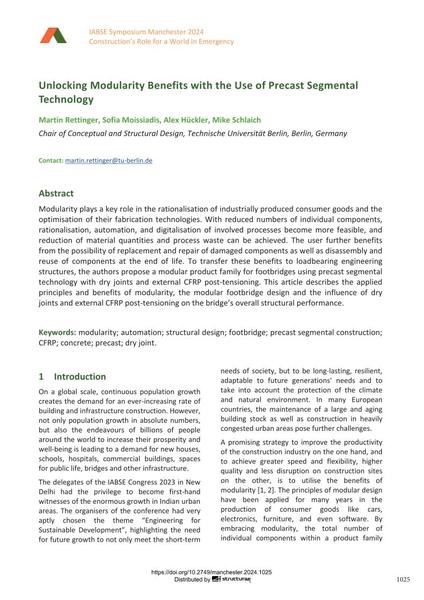Unlocking Modularity Benefits with the Use of Precast Segmental Technology

|
|
|||||||||||
Bibliographic Details
| Author(s): |
Martin Rettinger
(Chair of Conceptual and Structural Design, Technische Universität Berlin, Berlin, Germany)
Sofia Moissiadis (Chair of Conceptual and Structural Design, Technische Universität Berlin, Berlin, Germany) Alex Hückler (Chair of Conceptual and Structural Design, Technische Universität Berlin, Berlin, Germany) Mike Schlaich (Chair of Conceptual and Structural Design, Technische Universität Berlin, Berlin, Germany) |
||||
|---|---|---|---|---|---|
| Medium: | conference paper | ||||
| Language(s): | English | ||||
| Conference: | IABSE Symposium: Construction’s Role for a World in Emergency, Manchester, United Kingdom, 10-14 April 2024 | ||||
| Published in: | IABSE Symposium Manchester 2024 | ||||
|
|||||
| Page(s): | 1025-1033 | ||||
| Total no. of pages: | 9 | ||||
| DOI: | 10.2749/manchester.2024.1025 | ||||
| Abstract: |
Modularity plays a key role in the rationalisation of industrially produced consumer goods and the optimisation of their fabrication technologies. With reduced numbers of individual components, rationalisation, automation, and digitalisation of involved processes become more feasible, and reduction of material quantities and process waste can be achieved. The user further benefits from the possibility of replacement and repair of damaged components as well as disassembly and reuse of components at the end of life. To transfer these benefits to loadbearing engineering structures, the authors propose a modular product family for footbridges using precast segmental technology with dry joints and external CFRP post-tensioning. This article describes the applied principles and benefits of modularity, the modular footbridge design and the influence of dry joints and external CFRP post-tensioning on the bridge’s overall structural performance. |
||||
| Keywords: |
concrete structural design modularity footbridge precast dry joint precast segmental construction automation CFRP
|
||||
